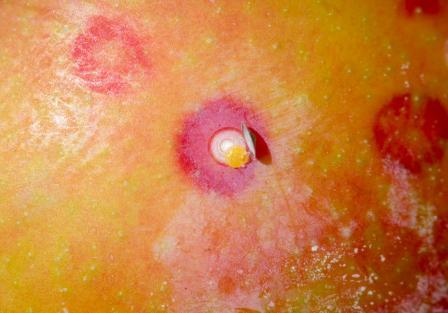We are seeing an uptick in samples of an armored scale commonly called the San Jose Scale, Quadraspidiotus perniciosus (Comstock). Don’t be fooled by the common name–it is not originally from California or even from America. It originated in China, but was introduced into Southern California back in the early 1870s on peach trees that were imported. By the 1890s it had spread throughout the United States. It was transported on fruit trees that were moved around by nurseries and uninformed horticulturists.
In many nurseries, growers have started producing larger fruit trees to sell to customers who want full size fruit trees that already bear fruit. With this influx of trees that are grafted, several are slipping through that have low populations of this armored scale on the trunk or branches. Several nurseries have submitted branch samples loaded with female scale present to our CMREC lab.

The scale is a tiny insect that sucks the plant juices from twigs, branches, fruit and foliage. Although an individual scale cannot inflict much damage, a single female and her offspring can produce several thousand scales in one season. In the nursery, it may not be noticeable for the 3 or 4 years it is growing in the nursery row but it will become apparent when moved into the landscape. If uncontrolled, they can kill the tree.
Hosts
San Jose scale is most destructive on apple and pear, but it can be a serious pest of sweet cherry, peach, prune, and other tree fruits. It also attacks nut trees, berry bushes, and many kinds of shade trees and ornamental shrubs. We are having samples submitted with this scale on flowering plums and crabapples.
Description
The mature male is a very small, yellowish-tan insect with wings and long antennae. The female is wingless and legless, and its yellow body is soft and globular. The covering of a full grown female is about the size of a pin head, with a central, nipple-like bulge. The covers tend to be light brown.
Life Cycle
San Jose scale overwinters as third instar females and cralwers occur in May in most years. There is a second generation in July –August and a third one in September, giving this scale plenty of chances to increase a population on plants in a single year.
Newly-hatched crawlers has six legs, two antennae and a bristle-like sucking beak that is almost three times the length of its tiny, oval body. The crawler seeks a suitable site to settle and immediately begins to secrete a waxy covering over its body, which hardens into a scale. The scale turns from white to black and then to gray and goes through several molts before maturing. The differences in sexes become apparent after the first molt, although the scales covering them are identical. The females are smaller and rounder than the males and have lost their eyes, legs and antennae.
Biological Control
There are several natural enemies that attack San Jose scale. On the east coast, the parasitoids recorded from San Jose scale include Encarsia perniciosi and Aphytis sp. Although they destroy many scales, they do not provide enough control to prevent damage. Natural enemies may become numerous in a nursery that are not sprayed with cover spray insecticides, but even under these conditions biological control has not been adequate. Currently, biological controls are only a supplement to chemical control.
Control Options
Dormant rates (2-3%) of horticultural oil sprays can be applied to the overwintering scales to suffocate them. Once a plant breaks dormancy then a 1% horticultural oil can be used.
A better (usually more expensive control) is to use insect growth regulators. There are two on the market. The first is Buprofezin (Talus for ornamentals, Applaud for use on fruit.)
Buprofezin (Applaud and Talus) is effective via contact, ingestion and vapor activity. In addition to its primary mode of action, Talus also suppresses egg-laying and causes egg sterilization in infected adults. Applaud and Talus is a contact insecticide inasmuch as it is neither absorbed by the plant nor translocated to growing points.
The second IGR is Pyriproxyfen sold under the names Distance (labeled for ornamental plants) and Esteem (labeled for use on fruit plantings.)
Both of these IGRs prevent the scale from developing into the next life stage, resulting in death. Impact on predators and parasites is greatly reduced over use of broader spectrum pesticides. With applications aimed at the crawler stage, timing is critical.
If you find this scale active in your area
Please send in samples if you think you have San Jose Scale. I will keep the information confidential, but I am trying to establish how widespread this armored scale is becoming in Maryland. My email is sgill@umd.edu.